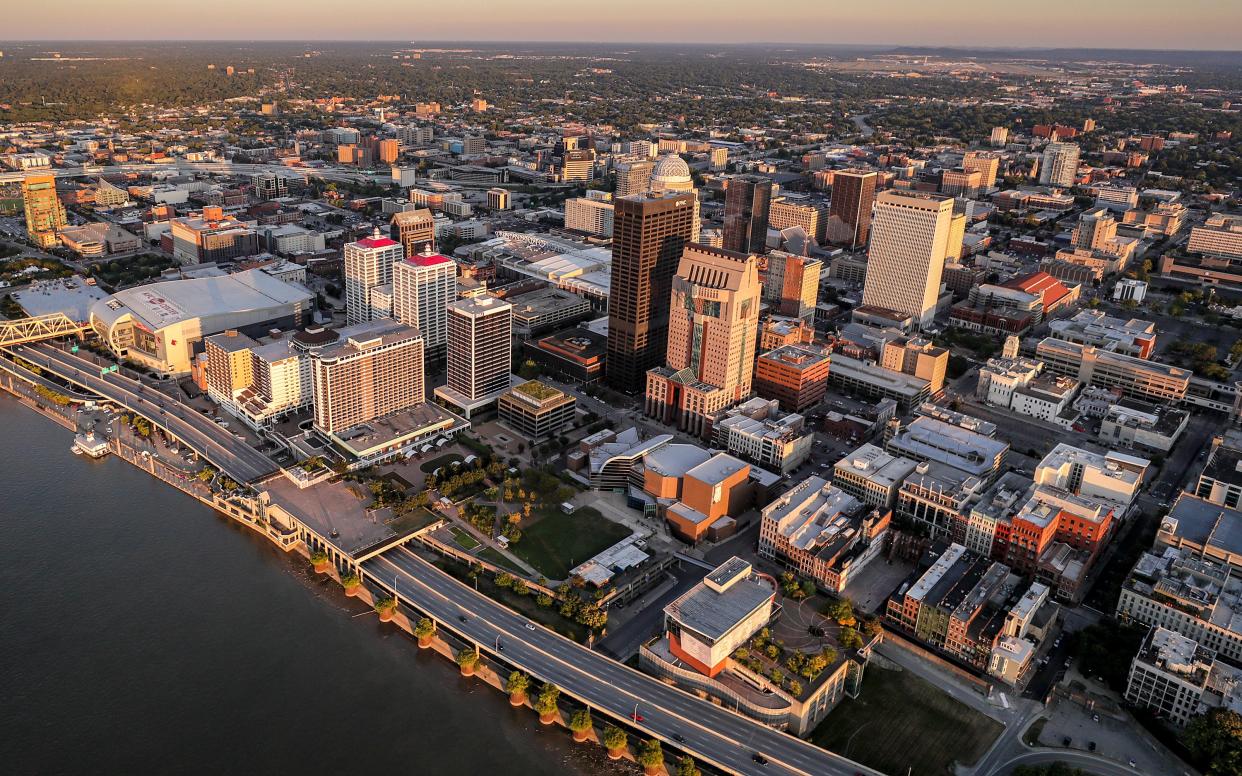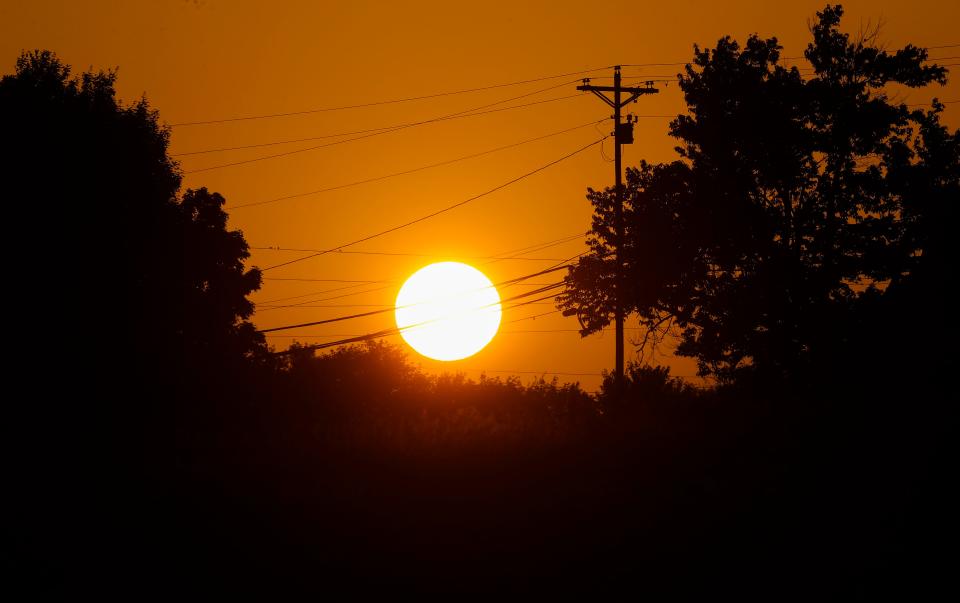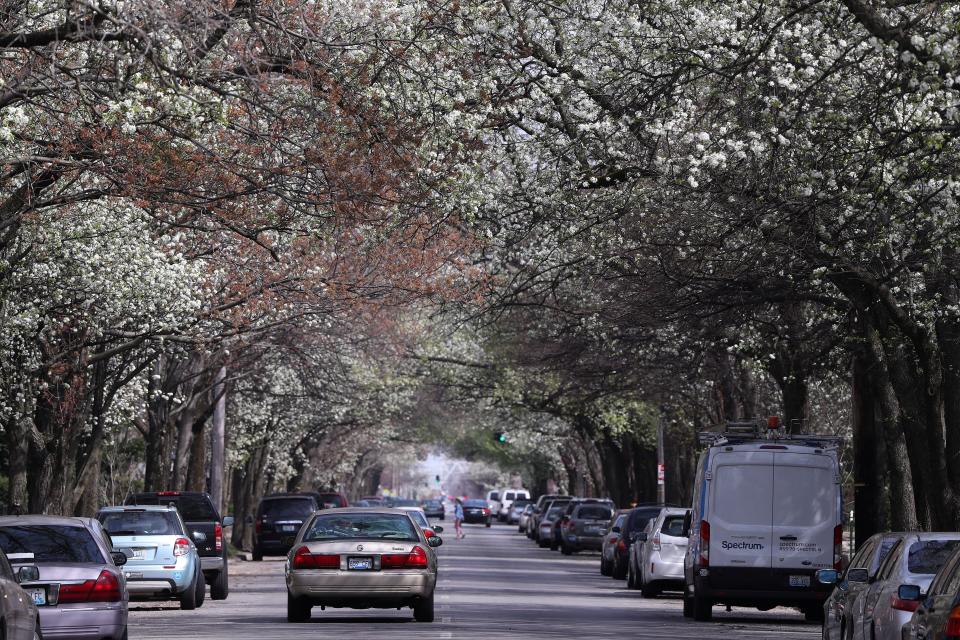These 4 charts show how the Louisville urban heat island is affecting your neighborhood

More than 526,000 people in the Louisville metropolitan area, about half of the population, are exposed to temperatures 8 degrees warmer or more because of the urban heat island effect, according to a hyperlocal data analysis released by Climate Central this week.
In one part of downtown, temperatures are elevated by more than 10 degrees Fahrenheit, the study estimates. The outskirts of Jefferson County could be prone to temperatures 6 degrees higher than in outlying rural areas.
The analysis comes as a wave of heat blankets Louisville this week. And earlier this month, Earth shattered heat records several days in a row — driven by this year's El Niño climate pattern and strengthened by climate change — reaching temperatures not seen in 125,000 years, according to USA TODAY reporting on preliminary data.
"What the urban heat island represents is additional heat on top of that already increasing temperature," said Jen Brady, who led the analysis. "And certain areas are getting a lot more of it than other areas."
In Louisville, a heat advisory has been issued for Thursday and Friday by the National Weather Service, with a high near 100 degrees forecasted for Friday. Temperatures in that range are a risk to public health, and unsustainable urban design can make them even more deadly.
What is the urban heat island effect?
The urban heat island effect refers to higher temperatures in cities compared to immediately neighboring rural areas, as heat-reducing vegetation is cleared to make room for roads, buildings and other impervious surfaces that absorb heat.
The analysis looked at factors like building surfaces, land cover, green spaces and population density to determine the effects on local temperatures.
For example, different building materials will retain different amounts of heat throughout the day. Tree canopy and other green spaces can cool communities, while high population density could be an indicator of higher concentrations of air conditioner use or vehicle traffic, both of which emit heat into their local environment.
How does Louisville's urban heat island compare?

The burden of Louisville's urban heat island was far from the worst in Climate Central's data. In parts of New York City, temperatures are boosted by an estimated 13 degrees, for example.
But the analysis, which looked at 44 cities across the U.S., shows Louisville's urban heat island outranking several other similar and larger cities.
A higher percentage of Louisville's residents are subject to an additional 8 degrees or more from the effect, compared to residents in Boston, Los Angeles or Washington, D.C., Climate Central estimates.
And the most intense area of urban heat island effect in Louisville was stronger than that of Austin, Memphis, Nashville and Jacksonville, among others. It also topped large cities in the west, including San Jose and Sacramento.
An older study deemed Louisville's urban heat island the fastest growing in the country. And the city's most recent assessment, conducted by Georgia Tech's Urban Climate Lab and released in 2016, found a similarly dire urban heat island, with heat contributing to the deaths of an average of 86 people each year in Louisville.
Who is most at risk from extreme heat?
Seniors, children, pregnant people, outdoor workers and unhoused populations are generally most at-risk for extreme heat.
And even before heat spiked this week, Louisville EMS made 83 heat-related runs from June 1 to July 24, according to city spokesperson Jess Wethington.
Catherine McGeeney, director of communications for the Coalition for the Homeless, said she's worried about how the growing impacts of climate change will intersect with Louisville's homelessness crisis.
"We are concerned about the lack of resources for unhoused people all year round, but it becomes particularly dangerous in extreme heat and extreme cold," McGeeney said.
A heat index above 95 degrees triggers Operation White Flag in Louisville, opening up participating emergency shelters. McGeeney said the city's shelters are underfunded, as are potential long-term solutions, like affordable housing programs.
And many of Louisville's neighborhoods with the most intense urban heat island effect are also areas of less wealth, where keeping an air conditioner running throughout a days-long heat wave may pose a considerable financial burden.
Extreme heat is worsening in Louisville
Not every future summer will necessarily be hotter than the last, but data shows a clear trend of warming summers in Louisville and elsewhere — a trend climate scientists have confidently attributed to a changing climate driven by the burning of fossil fuels, deforestation and other human activities.
Louisville could average 15 days per year of temperatures above 100 degrees by the middle of this century, or 41 days by the end of the century, if greenhouse gas emissions are not reduced drastically, according to federal climate projections.
For comparison, Louisville averaged 0.7 days per year above 100 degrees from 1976 to 2005.
Related: Grow your own shade: Plant a tree and get money back from Trees Louisville. Here's how:
How can Louisville mitigate urban heat?
While Brady acknowledges the grim implications of the urban heat analysis, it's also a local issue that can have local solutions.
Working with neighbors to encourage cool roofing, plant more trees and establish or expand local green spaces can create a meaningful decline in urban temperatures, she said.
The city's urban heat report from 2016 called for a rapid rollout of cooling methods, including planting far more trees and preserving existing tree canopy.

Since then, TreesLouisville has reported modest improvements in the city's tree cover, reversing a trend of severe canopy loss. But some residents have raised concerns about intensive tree removal around the county, whether from land clearing for development or for improving visibility of billboards, in light of Louisville's considerable urban heat burden.
Cool roofing — changing the surface material or color of roofs to help them reflect sunlight, rather than absorb it — is incentivized by Louisville Metro at a rate of $1 per square foot.
The program has already reached 300 property owners, with more than a million square feet of roofs converted, according to Sumedha Rao, executive director of the mayor's Office of Sustainability.
Environment: Ohio River listed as endangered. What that means and what can be done to help.
The office is also responsible for strategizing the city's shift toward net-zero emissions, and is working toward more cooling centers and water stations for the public to address heat.
The 2016 urban heat study helped Louisville officials "understand how urban heat is a really important issue locally, and also how it's inequitable in the way that it impacts the city," Rao said. This week's analysis adds to that wealth of information.
"We acknowledge that this is gonna be a growing problem in the future," she said.
Connor Giffin is an environmental reporter for The Courier Journal and a corps member with Report for America, a national service program that places journalists in local newsrooms to report on under-covered issues. The program funds up to half of corps members’ salaries, but requires a portion also be raised through local community fundraising. To support local environmental reporting in Kentucky, tax-deductible donations can be made at courier-journal.com/RFA.
Learn more about RFA at reportforamerica.org. Reach Connor directly at cgiffin@gannett.com or on Twitter @byconnorgiffin.
This article originally appeared on Louisville Courier Journal: How the urban heat island affects your Louisville neighborhood

